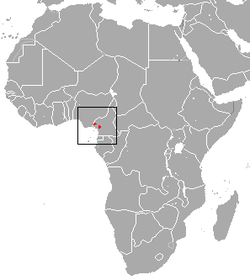| Preuss's red colobus [1] | |
|---|---|
 | |
| Scientific classification | |
| Kingdom: | Animalia |
| Phylum: | Chordata |
| Class: | Mammalia |
| Order: | Primates |
| Suborder: | Haplorhini |
| Infraorder: | Simiiformes |
| Family: | Cercopithecidae |
| Genus: | Piliocolobus |
| Species: | P. preussi |
| Binomial name | |
| Piliocolobus preussi Matschie, 1900 | |
 | |
| Preuss's Red Colobus range | |
Preuss's red colobus (Piliocolobus preussi) is a red colobus primate species endemic to the Cross-Sanaga Rivers ecoregion. An important population occurs in Korup National Park, Southwest Province, Cameroon, but the species' distribution is localized (groups are frequently encountered near the main tourist camps). The species is considered present in adjacent Cross River National Park - Oban Division in Nigeria [2] and hunter reports suggest that few groups remain in Nkwende Hills and Nta Ali Forest Reserve in the broader Korup region. [3] A population is also present in Ebo forest, Littoral Province of Cameroon. [2]
